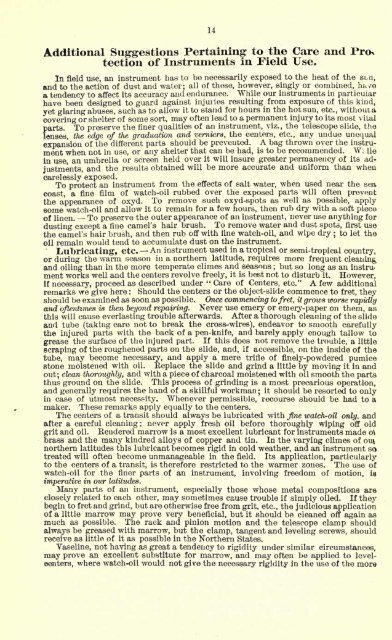STANDARD - Survey Instrument Antique Center!
STANDARD - Survey Instrument Antique Center!
STANDARD - Survey Instrument Antique Center!
You also want an ePaper? Increase the reach of your titles
YUMPU automatically turns print PDFs into web optimized ePapers that Google loves.
14<br />
Additional Suggestions Pertaining to the Care and Pro*<br />
tection of <strong>Instrument</strong>s in Field Use.<br />
In field use, an instrument has to be necessarily exposed to the heat of the sun,<br />
and to the action of dust and water; all of these, however, singly or combined, ha/e<br />
a tendency to affect its accuracy and endurance. While our instruments in particular<br />
have been designed to guard against injuries resulting from exposure of this kind,<br />
yet glaring abuses, such as to allow it to stand for hours in the hot sun, etc., without a<br />
covering or shelter of some sort, may often lead to a permanent injury to its most vital<br />
parts. To preserve the finer qualities of an instrument, viz., the telescope slide, the<br />
lenses, the edge of the graduation and verniers, the centers, etc., any undue unequal<br />
expansion of the different parts should be prevented. A bag thrown over the instrument<br />
when not in use, or any shelter that can be had, is to be recommended. Wi ile<br />
in use, an umbrella or screen held over it will insure greater permanency of its adjustments,<br />
and the results obtained will be more accurate and uniform than when<br />
carelessly exposed.<br />
To protect an instrument from the effects of salt water, when used near the sea<br />
coast, a fine film of watch-oil rubbed over the exposed parts will often prevent<br />
the appearance of oxyd. To remove such oxyd-spots as well as possible, apply<br />
some watch-oil and allow it to remain for a few hours, then rub dry with a soft piece<br />
of linen. To preserve the outer appearance of an instrument, never use anything for<br />
dusting except a fine camel's hair brush. To remove water and dust spots, first use<br />
the camel's hair brush, and then rub off with fine watch-oil, and wipe dry to let the<br />
;<br />
oil remain would tend to accumulate dust on the instrument.<br />
Lubricating, etc. An instrument used in a tropical or semi-tropical country,<br />
or during the warm season in a northern latitude, requires more frequent cleaning,<br />
and oiling than in the more temperate climes and seasons ; but so long as an instru.<br />
ment works well and the centers revolve freely, it is best not to disturb it. However,<br />
If necessary, proceed as described under "Care of <strong>Center</strong>s, etc." A few additional<br />
remarks we give here : Should the centers or the object-slide commence to fret, they<br />
should be examined as soon as possible. Once commencing to<br />
fret, it grows worse rapidly<br />
and oftentimes is then beyond repairing. Never use emery or emery-paper on them, as<br />
this will cause everlasting trouble afterwards. After a thorough cleaning of the slide<br />
and tube (taking care not to break the endeavor to smooth<br />
cross-wires}, carefully<br />
the injured parts with the back of a pen-knife, ana barely apply enough tallow to<br />
grease the surface of the injured part. If this does not remove the trouble, a little<br />
scraping of the roughened parts on the slide, and, if accessible, on the inside of the<br />
tube, may become necessary, and apply a mere trifle of finely-powdered pumice<br />
stone moistened with oil. Replace the slide and grind a little by moving it in and<br />
out; clean thoroughly, and with a piece of charcoal moistened with oil smooth the parts<br />
thus ground on the slide. This process of grinding is a most precarious operation,<br />
and generally requires the hand of a skillful workman; it should be resorted to only<br />
in case of utmost necessity. Whenever permissible, recourse should be had to a<br />
maker. These remarks apply equally to the centers.<br />
The centers of a transit should always be lubricated with fine watch-oil only, and<br />
after a careful cleaning; never apply fresh oil before thoroughly wiping off old<br />
grit and oil. Rendered marrow is a most excellent lubricant for instruments made o\<br />
brass and the many kindred alloys of copper and tin. In the varying climes of oui<br />
northern latitudes this lubricant becomes rigid in cold weather, and an instrument so<br />
treated will often become unmanageable in the field. Its application, particularly<br />
to the centers of a transit, is therefore restricted to the wanner zones. The use of<br />
watch-oil for the finer parts of an instrument, involving freedom of motion, is<br />
imperative in our latitudes.<br />
Many parts of an instrument, especially those whose metal compositions are<br />
closely related to each other, may sometimes cause trouble if simply oiled. If they<br />
begin to fret and grind, but are otherwise free from grit, etc., the judicious application<br />
of a little marrow may prove very beneficial, but it should be cleaned off again as<br />
much as possible. The rack and pinion motion and the telescope clamp should<br />
always be greased with marrow, but the clamp, tangent and leveling screws, should<br />
receive as little of it as possible in the Northern States.<br />
Vaseline, not having as great a tendency to rigidity under similar circumstances,<br />
may prove an excellent substitute for marrow, and may often be applied to leveloenters,<br />
where watch-oil would not give the necessary rigidity in the use of the more


